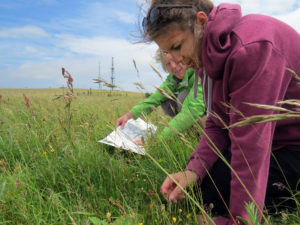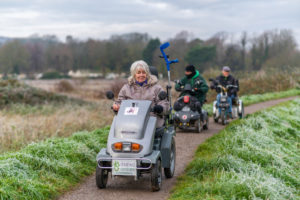Outcome 5: Outstanding Experiences
Outstanding experiences for communities and visitors are supported by high quality access and sustainable transport networks.
- WHY IS IT IMPORTANT?
National Parks are designated for everyone, and the South Downs provides
outstanding recreational opportunities associated with its natural beauty, wildlife and cultural heritage.It is really important that local communities, and visitors have a wide range of
opportunities to learn and be inspired, and to improve their health and wellbeing.However, evidence to date shows that certain groups have been consistently under-represented.
The most recent Authority visitor survey indicated that 98% of visitors rated their
experience of the National Park as high or very high, 77% of visitors counted our scenic landscapes and breath-taking views as key factors in their enjoyment, and going for a walk was by far the most popular activity amongst visitors − with 73% identifying this as their main activity.The priorities in this chapter will help improve these experiences, enabling more
participation by addressing barriers to access, and manage the pressures of growing visitor numbers in certain hotspots.To give one example, barriers on the Rights of Way network include steps and stiles which prevent access by less mobile individuals, and a lack of good ‘family friendly’ routes connecting to major settlements in and around the National Park.
In most areas these are compounded by poorly promoted public transport and declining bus services. The severance caused by major highways on the edge of the National Park, such as the A27 and M3, and increasing traffic flows on roads within it, is also significant.
For this outcome our priorities for the next five years are:
- 5.1 A NATIONAL PARK FOR ALL
To enable everyone to experience the National Park and widen participation for under-represented groups through targeted activities and promotion.
The visitor profile of the National Park shows that certain groups are currently under-represented.
In particular:
- Young people (16−24) − Staying visitors are much more likely to be from older age groups (>55 years).
- People from Black, Asian and Minority Ethnic (BAME) communities. Our visitors are overwhelmingly white, with only 1% from BAME communities (compared to 14.8% in the populations surrounding the National Park).
- People with disabilities − 26% of people polled cited ‘Health issues prevent me’ as a key reason for not visiting.
- People from areas of social deprivation − 16% of people surveyed said they ‘can’t afford to go/it is too expensive’ as a main reason for not visiting. There are people struggling in the most apparently affluent areas.
Working together this Plan aims to improve access for everyone by reducing the barriers to visiting the National Park. These include:
- Physical barriers: including gates, stiles, path surfaces and steep gradients
- Economic barriers: for young people who don’t drive or have low incomes, it can be expensive to travel, to stay places, to eat and to join activities.
- Cultural and social barriers: lack of appropriate information can be a significant
barrier. Evidence suggests individuals who have had a positive experience are more likely to share information within their communities, and this has greater impact than officially produced literature.
Example: Families Inclusion Project using the John Muir Award
 For families and young people who have had little access to wild places, often from the most deprived sectors of society, working together in nature to a shared goal offers ways to share new and positive experiences and to improve wellbeing.
For families and young people who have had little access to wild places, often from the most deprived sectors of society, working together in nature to a shared goal offers ways to share new and positive experiences and to improve wellbeing.The John Muir Award is an environmental scheme focused on wild places. It
supports people to connect with, enjoy and care for nature, landscapes and
the natural environment. It’s for people of all backgrounds and ages, is non-competitive, inclusive and accessible.The Award asks participants to meet four challenges:
- Discover a wild place.
- Explore it by a walk, camp, bike ride or cycle.
- Conserve it through practical conservation or campaigning.
- Share your experiences through making a film, talking to friends and
family, or making a display of photos or poems.
Since 2014, the Authority has used the award very successfully to engage schools
and outdoor learning organisations. Building on this success we are now extending
the scheme to families who live in areas of deprivation around the National Park,
working in partnership with already established groups at support centres in towns and cities including Food Banks, Sure Start Centres and Social Services. - 5.2 IMPROVE ACCESSIBILITY
To improve accessibility through a network of high quality routes connecting communities with the landscape, heritage, attractions and transport hubs and gateways.
With over 3300km of public paths, this National Park has one of the most extensive Rights of Way networks in the country. The 2018 visitor survey showed 73% of visitors came to enjoy a walk, yet many people who live close
by are not experiencing it. There is a shortage of ‘family friendly’ paths suitable for inexperienced cyclists and vulnerable users.Connectivity from market towns and transport hubs can be an issue, and major highway corridors – in particular across the A27 to the coastal fringe, and across
the M3 to Winchester − present significant barriers to access.The Authority Strategy for Cycling and Walking sets out an ambitious agenda to
improve accessibility for all by creating a network of traffic free routes that are easily reached by communities within and near to the National Park, and which are well connected to public transport.It is now firmly understood that being out in nature is good for us. Enabling more people to access the National Park for walking, cycling, horse riding and other activities creates multiple benefits.
It improves health and wellbeing, encourages greater visitor spend in the local
economy, eases traffic hotspots, and improves air quality by taking cars off the road.A wide range of projects are underway or planned by various partners. These range from strategic off-road routes for Non-Motorised Users to Miles without Stiles programme, which is opening up more of the National Park to the less
mobile by removing stiles and path resurfacing.Many of the projects feature in Local Highways Authorities’ Local Transport Plans and Countryside Access or Rights of Way Improvement Plans.
Example: Miles without Stiles
 Many people have difficulty or are excluded from enjoying the National Park due to physical barriers on the rights of way network.
Many people have difficulty or are excluded from enjoying the National Park due to physical barriers on the rights of way network.Small changes can make a huge difference to the accessibility of our network. A
partnership with Gatwick Airport, the South Downs National Park Trust and the Authority has made £60,000 available over 3 years to improve access to open up large areas of the existing network to a wider audience.Work has included physical improvements to the network and the publication of better information to promote accessible areas.
The partnership aims to work with our rights of way authorities to continue to
improve the access network through many small interventions that, together,
have a big impact. - 5.3 ENCOURAGE SUSTAINABLE TRANSPORT
To encourage sustainable access into and around the National Park, encouraging the retention and expansion of rural transport services.
The South Downs is under huge pressure from car use. The 2018 Visitor Survey estimates that 77% of visits were made by car, creating carbon emissions, air pollution, noise and congestion.
Improving public transport into and around the boundary is therefore vital.
Parts of the National Park are well served by rail, with stations acting as visitor gateways linking directly to destinations such as the South Downs Way National Trail, or connecting with bus routes for onward travel.
However, evidence shows that visitors still need more information
about how to get around and that there is a lack of confidence in the ‘final mile’ – meaning visitors arriving by more sustainable modes are uncertain of how to reach their end destination.This is being tackled through a variety of projects including the development of Travel Hubs at gateway stations; digital mapping, on the ground signposting and more joined up ticketing services.
The retention and expansion of rural transport services is a key issue for the National Park. A transport network that works for both residents and visitors is a critical factor in supporting communities and enabling outstanding visitor experiences, yet rural bus services have reduced in the last five years through cuts in the budgets of Passenger Transport Authorities.
This is having an impact on young people’s ability to access education and employment, and is increasing isolation among elderly or disabled rural residents without access to a car.
Nationally, trends in transport suggest mobility services will look very different in the future, with continuing decline in scheduled routes but the rise of more app-based, on demand, sharing services.
Without strong advocacy it is unlikely that rural areas will become early adopters of these new technologies, but partners in the South Downs are very keen to find new ways of keeping rural communities connected and would therefore welcome innovative pilot projects within this period of the Plan.
